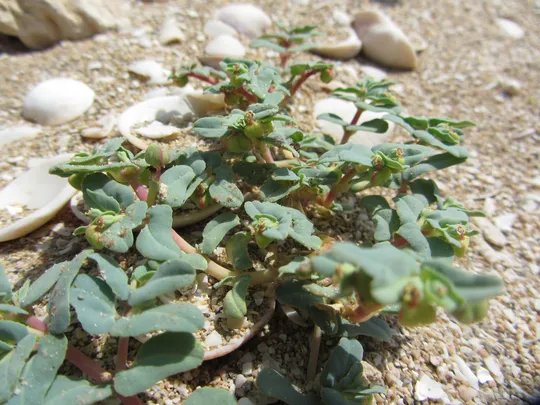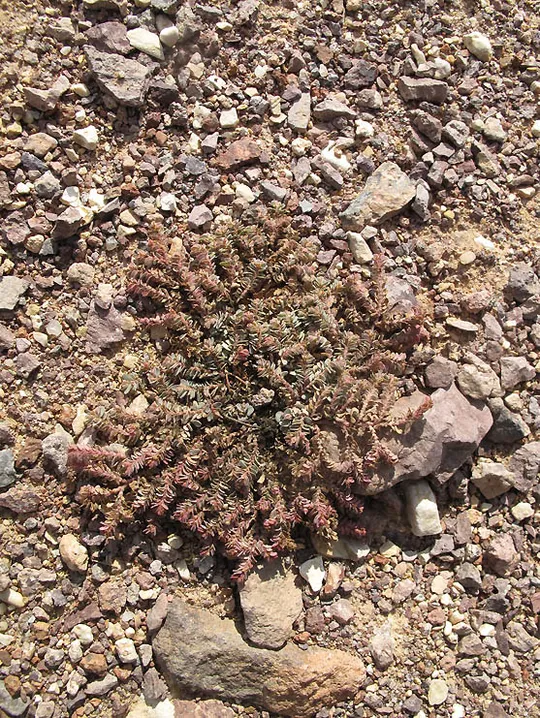Purple Spurge
Euphorbia peplis

Euphorbia peplis grows in all the Mediterranean
coastal regions in
Israel – the
Acre Valley, Carmel Coast, Sharon and Philistian Plain. The rare species survey conducted in 1994-1995 in the coastal regions of Acre, the Carmel and the Sharon found 6-8 E. peplis sites in each
region. Urban sites, which were recorded in
1924-1950 (Bat Galim, Netanya) and in the Kishon Bay (port and industrial
construction), are extinct. In the Philistian Plain, seven sites were known and
four of them have since become extinct, two of them from the Tel Aviv beach. It
is likely that since the survey of the mid-1990s, additional populations have become extinct and the number of sites has decreased even more. Recently (2005) the plant was observed on the Gaza coast near Tel al-Katifa (Oz Golan)
Euphorbia peplis grows on the Mediterranean coast, in the playa zone at a
distance of 5-100 meters from the shoreline, both on quartz and calcareous sand. E. peplis belongs
to the Ipomoea imperati and Salsola
tragus community that is dominant on the unstabilized sandy beach zone. It
grows in exactly the same habitat in its global range: in Turkey it also grows
on the shores of inland and saline lakes.
For the genus – see Euphorbia
phymatosperma.
E. peplis belongs to the Chamaesyce sub-genus within
the huge Euphorbia genus. The
group is characterized by short-lived annual or
perennial prostrate plants; their leaves are opposite with minuscule lanceolate stipules; there is no separation between the
leaves of the stem and the inflorescence, and the flowers grow alongside the
leaves almost from the base of the plant; the four inflorescence glands have colored additions with simple or dentate edges. Because of its numerous morphological characters, many scholars tend to consider this group as an independent genus, Chamaesyce, separate
from the genus Euphorbia. In Israel, the following species belong to
this group: E. chamaesyce, E. granulata, E. maculata, E. serpens
and E. forskalii. It is easy to distinguish E. peplis from the other species
as it is completely glabrous and has bluish succulent leaves.
• In 1994-1995,
25 Euphorbia peplis sites were
counted along the Mediterranean coast from Akhziv
south to Nitsanim. Increasing coastal development and recreational
activities are likely to threaten the species further, as it grows on the playa zone frequented by
bathers.
• E. peplis was once much more common on beaches in Israel.
• The number of E. peplis sites in the Philistian Plain region are diminishing and are rapidly becoming extinct, probably because of the dry conditions and because the area is at the edge of its regional distribution.
•
Information on E. peplis population sizes
is incomplete. Usually a few plants are found
at each site. The coastal population
of Shave-Tsion,
which comprises 3000 plants (1994) on an area of 3 hectares, deserves
particular mention.
• Most of populations are
outside nature reserves, and not a single population is safe from harm.
Euphorbia peplis
populations should be surveyed along the Mediterranean
coast and the results compared to those obtained in 1995. Two beaches
should be demarcated and signposted, one in the north (Shave
Tsion) and one in the south (Nitsanim),
and their populations should be monitored.
Euphorbia peplis
is a coastal plant that grows on the shores of the Mediterranean Sea, the Black Sea and
the southern Caspian Sea. It also grows in the Atlantic Ocean in the Canary
Islands, Madeira, and the Azore Islands and on the Atlantic coast of Europe to northern
France. In the Middle East, it grows on the Mediterranean shores of Egypt, Israel, Cyprus, Lebanon and Syria and along the entire coast of Turkey. There are
records of the species from northern Sinai, from the Arabian coast and the
Persian Gulf, but they are not certain.
Euphorbia peplis is an annual
plant that grows on the coastal plain on seashore playas. The number of its sites decreased significantly, and its populations and habitat are severely
endangered because of human activities on the beaches.
Current Occupancy Map
| 1000 squre meter pixel | 5000 squre meter pixel | 10000 squre meter pixel | |
|---|---|---|---|
| number of observations | 0 | 0 | 0 |
| in total pixels | 0 | 0 | 0 |
| Family | Euphorbiaceae |
| Classification | On the endangered species list |
| Ecosystem | Mediterranean Coastal area |
| Chorotype | Mediterranean (Euro-Siberian) |
| Conservation Site | Shave-Tsion Beach |
| Rarity |
1
2
6
|
|---|---|
| Vulnerability |
0
4
4
|
| Attractiveness |
0
0
4
|
| Endemism |
0
0
4
|
| Red number |
1
3.2
10
|
| Peripherality | 0 |
| IUCN category | DD EW EX LC CR EN VU NT |
| Threat Definition according to the red book | Vulnerable |
 Based on:
Based on:





